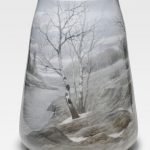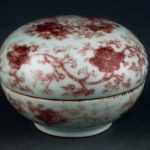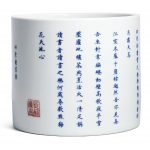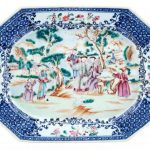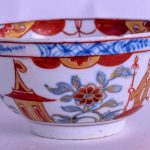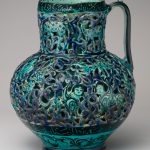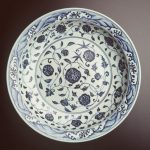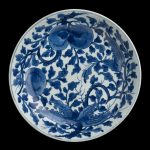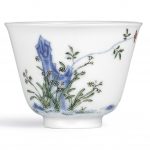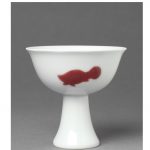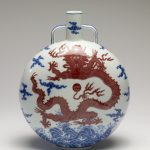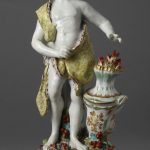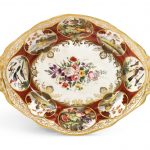Underglaze is a method of decorating pottery in which painted decoration is applied to the surface before it is covered with a transparent ceramic glaze and fired in a kiln. Because the glaze subsequently covers it, such decoration is completely durable, and it also allows the production of pottery with a surface that has a uniform sheen. Underglaze decoration uses pigments derived from oxides which fuse with the glaze when the piece is fired in a kiln. It is also a cheaper method, as only a single firing is needed, whereas overglaze decoration requires a second firing at a lower temperature. Reference: Wikipedia
A monumental porcelain vase ‘Deep River’ from the Imperial Anichkov palace Imperial Porcelain Factory, artist G.D. Zimin, St. Petersburg, 1910 of tapering form, painted overall with continuous early spring landscape depicting a river, birch and other trees, banks and fields covered with melting snow, boulders and rocks cascading to the flowing water; all against the expanding depth of the pale blue sky and billowing clouds, all finely painted underglaze in monochromatic hues of brown, grey and light blue, marked on underside with green underglazed factory mark and date ‘1910’, with attached paper label of Imperial Anichkov palace height: 45.4cm (17 7/8in).
Sold for £ 50,000 inc. premium at Bonhams in 2018
Circular porcelain box with domed cover. There are stylised lotus flowers in underglaze copper red with incised detail on the exterior, and a leaf pattern incised on the mouth rim of the lower half. There is a mark in underglaze cobalt blue on the base. Qing dynasty Kangxi Date 1662-1722
Reference: © The Trustees of the British Museum
A RARE UNDERGLAZE-BLUE AND COPPER-RED DECORATED INSCRIBED BRUSH POT KANGXI SIX-CHARACTER MARK IN UNDERGLAZE BLUE AND OF THE PERIOD (1662-1722) The brush pot is finely inscribed in underglaze blue with a long poem, the title of the poem indicated in the beginning reading ‘The Joy of Studying throughout the Four Seasons’, followed by a copper-red square seal reading Xichao chuangu. The bi-shaped base has an unglazed ring, reserving a sunken glazed centre inscribed with the reign mark. 7 ½ in. (19.1 cm.) diam., box
Sold for HKD 4,300,000 at Christies in 2018
Chinese Export Underglaze Blue and Famille Rose Porcelain Platter 18th Century With canted corners and painted with figures. Length 12 3/4 inches.
Sold for $750 (includes buyer’s premium) at Doyle New York in 2018
18th c. Worcester tea bowl painted with flowers in underglaze blue and overglaze decorated in London with two Chinamen holding spears
Sold for £200 at Hannam’s Auctioneers Ltd in 2019
Pierced Jug with Harpies and Sphinxes,dated A.H. 612/ A.D. 1215–16 With a carved and pierced outer shell that surrounds a solid inner container, this intricate feat of pottery emulates a metal object. The openwork–featuring Harpies (mythical birdwomen), Sphinxes, quadrupeds (four-footed mammals), and scrolls–was first painted with touches of black and cobalt blue. The entire jug was then covered in a transparent turquoise glaze. The Persian verses around the rim were written by the poet Rukn al-Din Qummi, and an anonymous love poem near the base includes the date of production.
Reference: The Metropolitan Museum of Art
Large porcelain dish with underglaze blue decoration Made in Jiangxi Province, China, 1628-1644. Large porcelain dishes such as this were produced in Jingdezhen, Jiangxi province, China, during the early 15th century. The centre of the dish is painted in underglaze blue with a composite floral design comprising four large flower heads on a meandering stem, alternating with buds, pomegranates and varied leaves. A continuous floral scroll ornaments the cavetto (concave sides of the bowl) and is repeated on the outside, and the rim is freely decorated with a pattern of crested waves. The base is unglazed and has a low, wedge-shaped foot rim.
Reference: Museum of Applied Art and Sciences
Dish with underglaze blue decoration of peaches and Buddhist hand citron Chinese Qing dynasty, Kangxi period 1662–1722
Six character mark of Kangxi in underglaze blue
Reference: Museum of Fine Arts Boston
A FINE AND RARE WUCAI ‘NARCISSUS’ MONTH CUP MARK AND PERIOD OF KANGXI delicately potted of deep ‘U’-shape with flared rim and a short straight foot, painted on one side in the wucai palette in underglaze blue and overglaze enamels with two clumps of narcissus, the larger one with a blue rock behind and a single red rose emerging from its midst, representing the twelfth month, the reverse inscribed with a poem relating to the flowers in front, followed by the seal shang (‘to appreciate’), the base inscribed in underglaze blue with a six-character reign mark within a double circle 6.6 cm, 2 5/8 in.
Sold for 2,250,000 HKD at Sothebys in 2019
Porcelain stem cup with high foot, painted in underglaze copper red with three stylised fish, equally distanced. A six-character mark in a double circle is painted in underglaze blue inside the foot.
This cup was produced in the imperial kilns of Jingdezhen in south China during the reign period of the emperor Kangxi (1662-1722). The decoration of the three stylised fishes in underglaze red was made after a Ming original of the 15th century, and a mark of the Xuande emperor (1426-1435) is painted in the inside. The practice of adding marks of earlier periods can often be seen on Chinese porcelain. In this case, the combination of the Xuande mark with a decorative style of the Ming dynasty can be interpreted as an homage to the past and a form of reverence to earlier dynasties.
Reference: © Victoria and Albert Museum
This moonflask of white porcelain is painted with underglaze blue and red designs. A five-clawed red dragon is depicted on either side, facing forward with its body coiled to protect a flaming pearl at the center. Flames issue from the scaly serpentine body of the dragon. In blue are painted the foaming crested waves along the bottom and scrolling clouds scattered across the sky. The flask is round in form, thus giving it the name full moon flask. Two thin handles are attached at the shoulders and rise to meet the straight narrow neck. The careful control of the cobalt (blue) and iron (red) pigments mark this vase as something rare and special. It was made at the imperial kilns in the city of Jingdezhen for the court in Beijing where it would have served as decoration for one of the many palace rooms in the Forbidden City. The Qianlong emperor who reigned from 1736 to 1796 was a great patron of the arts, commissioning and supporting production of vast numbers of exquisite works of art. This piece is marked as having been made during his reign and it is undoubtedly among the finest porcelains to emerge from the Chinese kilns.
Reference: The Walters Art Museum
